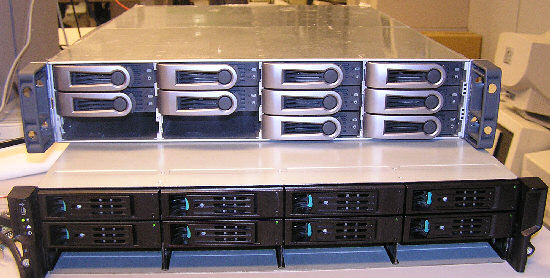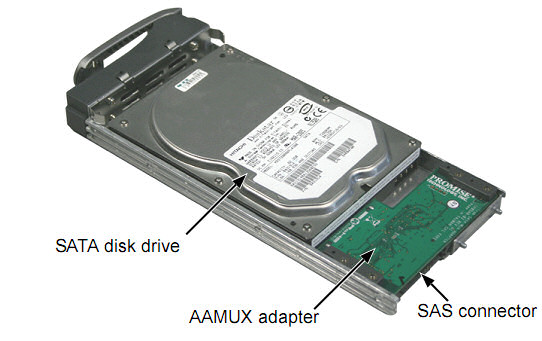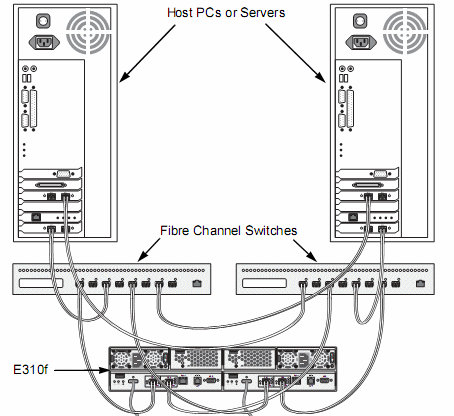Affordable storage for the SME, part one
by Johan De Gelas on November 7, 2007 4:00 AM EST- Posted in
- IT Computing
A different low-cost approach
In a first attempt to find affordable storage solutions, we gathered two interesting storage systems in our lab. The two systems are not really competitors but representatives of two different approaches to deliver high performance, centralized-but-affordable storage.

The Promise VTRAK E310f on top, the Intel SSR212MC2 on the bottom
The first option is the Promise VTRAK E310f, which is a fiber channel based storage rack. Promise's roots are in low-cost ATA RAID controllers. Recently Promise started to cater to the low-end and midrange enterprise storage market with a strong focus on keeping those racks affordable. The VTRAK E310f should thus give us a good idea whether or not it is possible to build a high performance but affordable solution with FC SAN building blocks.
The second system is the Intel SSR212MC2, which is an industry standard server optimized for storage. The reseller can turn it into anything he likes: a NAS, DAS, an iSCSI SAN, or an FC SAN. In this article, we will use the SSR212MC2 as an iSCSI SAN and (SAS) DAS. This will give us an idea what advantages and disadvantages an iSCSI device with industry standard parts has compared to a FC Appliance.
One of the big advantages that both the Intel and the Promise approach offer is that you can use industry standard hard disks and no one requires you to buy disks from the SAN manufacturer. While it is normal that a manufacturer tries to avoid users plugging unreliable hardware into their systems, this argument doesn't hold water when it comes to hard disks. After all, most OEMs also buy from Seagate, Fujitsu, and others. The big OEMs will force you to use their disks in two ways: either the controller will check the vendor of the disk ROM, or you will get "dummy trays". These trays don't allow you to add hard disks; the "real" hot-swappable trays come with the hard disks you order.
We decided to see how big the difference is between a "normal" hard disk and a "storage vendor hard disk". What you find below are the prices we could find for the end-user (second to last column) and the price range we could find when ordering extra disks when buying a storage systems from Dell/EMC, HP and IBM.

One reason why the "proprietary" SATA drives are a lot more expensive is that they usually include an Active-Active Multiplexer (AAMux). AAMUX technology enables single-ported SATA drives to connect like native dual-ported SAS drives for use in enterprise storage systems using SAS expanders. This is necessary if you want to mix SATA drives and SAS drives in the same enclosure. With an AAMux, two hosts can access a single SATA storage device independently, each through its own SATA interface. However, it is very unlikely the AAMUX device is enough to justify a $400 premium.

Granted, the premiums that vendors used to charge for "certified" disks used to be a lot bigger. Still, if you need high capacity courtesy of numerous hard disks, these premiums can rapidly add up to a significant amount of money. Let's take a closer look at pricing on a few options.
In a first attempt to find affordable storage solutions, we gathered two interesting storage systems in our lab. The two systems are not really competitors but representatives of two different approaches to deliver high performance, centralized-but-affordable storage.

The Promise VTRAK E310f on top, the Intel SSR212MC2 on the bottom
The first option is the Promise VTRAK E310f, which is a fiber channel based storage rack. Promise's roots are in low-cost ATA RAID controllers. Recently Promise started to cater to the low-end and midrange enterprise storage market with a strong focus on keeping those racks affordable. The VTRAK E310f should thus give us a good idea whether or not it is possible to build a high performance but affordable solution with FC SAN building blocks.
The second system is the Intel SSR212MC2, which is an industry standard server optimized for storage. The reseller can turn it into anything he likes: a NAS, DAS, an iSCSI SAN, or an FC SAN. In this article, we will use the SSR212MC2 as an iSCSI SAN and (SAS) DAS. This will give us an idea what advantages and disadvantages an iSCSI device with industry standard parts has compared to a FC Appliance.
One of the big advantages that both the Intel and the Promise approach offer is that you can use industry standard hard disks and no one requires you to buy disks from the SAN manufacturer. While it is normal that a manufacturer tries to avoid users plugging unreliable hardware into their systems, this argument doesn't hold water when it comes to hard disks. After all, most OEMs also buy from Seagate, Fujitsu, and others. The big OEMs will force you to use their disks in two ways: either the controller will check the vendor of the disk ROM, or you will get "dummy trays". These trays don't allow you to add hard disks; the "real" hot-swappable trays come with the hard disks you order.
We decided to see how big the difference is between a "normal" hard disk and a "storage vendor hard disk". What you find below are the prices we could find for the end-user (second to last column) and the price range we could find when ordering extra disks when buying a storage systems from Dell/EMC, HP and IBM.
| Hard Drive Price Comparison | |||
| Harddrive speed & interface | Capacity | Retail pricing (US) | Storage vendor pricing (US) |
| 15000 rpm SAS | 147 GB | $250-$300 | $370-$550 |
| 10000 rpm SAS | 300 GB | $200-$300 | $600-$850 |
| 10000 rpm FC | 300 GB | $450-$500 | $600-$950 |
| 7200 RPM SATA (Nearline) | 500 GB | $150-200 | $500-$800 |

One reason why the "proprietary" SATA drives are a lot more expensive is that they usually include an Active-Active Multiplexer (AAMux). AAMUX technology enables single-ported SATA drives to connect like native dual-ported SAS drives for use in enterprise storage systems using SAS expanders. This is necessary if you want to mix SATA drives and SAS drives in the same enclosure. With an AAMux, two hosts can access a single SATA storage device independently, each through its own SATA interface. However, it is very unlikely the AAMUX device is enough to justify a $400 premium.

Granted, the premiums that vendors used to charge for "certified" disks used to be a lot bigger. Still, if you need high capacity courtesy of numerous hard disks, these premiums can rapidly add up to a significant amount of money. Let's take a closer look at pricing on a few options.










21 Comments
View All Comments
Lifted - Wednesday, November 7, 2007 - link
I'm just wondering this sentence was linked to an article about a Supermicro dual node server. So you considere Supermicro an SME, or are you saying their servers are sold to SME's? I just skimmed the Supermicro article, so perhaps you were working with an SME in testing it? I got the feeling from the sentence that you meant to link to an article where you had worked with SME's in some respect.
JohanAnandtech - Wednesday, November 7, 2007 - link
no, Supermicro is not an SME in our viewpoint :-). Sorry, I should have been more clear, but I was trying to avoid that the article lost it's focus.I am head of a serverlab in the local university and our goal is applied research in the fields of virtualisation, HA and Server sizing. One of the things we do is to develop software that helps SME's (with some special niche application) to size their server. That is what the link is going towards, a short explanation of the stresstesting client APUS which has been used to help quite a few SMEs. One of those SMEs is MCS, a software company who develops facility management software. Basically the logs of their software were analyzed and converted by our stresstesting client into a benchmark. Sounds a lot easier than it is.
Because these applications are used in real world, and are not industry standard benchmarks that the manufacturers can tune to the extreme, we feel that this kind of benchmarking is a welcome addition to the normal benchmarks.
hirschma - Wednesday, November 7, 2007 - link
Is the Promise gear compatible with Cluster File Systems like Polyserve or GFS? Perhaps the author could get some commentary from Promise.JohanAnandtech - Wednesday, November 7, 2007 - link
We will. What kind of incompatibility do you expect? It seems to me that the filesystem is rather independent from the storage rack.hirschma - Thursday, November 8, 2007 - link
I only ask because every cluster file vendor suggests that not all SAN systems are capable of handling multiple requests to the same LUN simultaneously.
I can't imagine that they couldn't, since I think that cluster file systems are the "killer app" of SANs in general.
FreshPrince - Wednesday, November 7, 2007 - link
I think I would like to try the intel solution and compare it to my cx3...Gholam - Wednesday, November 7, 2007 - link
Any chance of seeing benchmarks for LSI Engenio 1333/IBM DS3000/Dell MD3000 series?JohanAnandtech - Wednesday, November 7, 2007 - link
I am curious why exactly?And yes, we'll do our best to get some of the typical storage devices in the labs. Any reason why you mention these one in particular (besides being the lower end of the SANs)
Gholam - Thursday, November 8, 2007 - link
Both Dell and IBM are aggressively pushing these in the SMB sector around here (Israel). Their main competition is NetApp FAS270 line, which is considerably more expensive.ninjit - Wednesday, November 7, 2007 - link
It's a good idea to define all your acronyms the first time you use them in an article.Sure, a quick google told me what an SME was, but it's helpful to the casual reader, who would otherwise be directed away from your page.
What's funny, is that you were particular about defining FC, SAN, HA on the first page, just not the title term of your article.